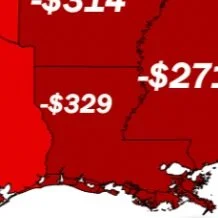The U.S. Department of Agriculture (USDA) recently announced the opening of 17 new Urban Service Centers in the next year including one in New Orleans. The USDA’s Farm Service Agency (FSA) and Natural Resources Conservation Service (NRCS) are hosting the grand opening of the new Urban Service Center in New Orleans at 10 a.m. on Wednesday, August 23. The grand opening will take place at the Urban Service Center located at 2520 Bayou Road New Orleans, LA 70119.
Read MoreThe U.S. Department of Agriculture (USDA) today announced approximately $530 million in additional, automatic financial assistance for qualifying guaranteed Farm Loan Programs (FLP) borrowers who are facing financial risk. The announcement is part of the $3.1 billion to help certain distressed farm loan borrowers that was provided through Section 22006 of the Inflation Reduction Act (IRA).
Read MoreThe Crop Production report issued today by USDA’s National Agricultural Statistics Service (NASS) forecasted corn production up from 2022 and soybean production down from last year. Corn production is up 10% from last year, forecast at 15.1 billion bushels; soybean growers are expected to decrease their production 2% from 2022, forecast at 4.21 billion bushels.
Read More
This report contains the results from the 2023 August Ag Yield Survey.
Read MoreCalifornia native Floyd D. Harris III knows that perseverance and hard work pay off. A recent graduate of Southern University, an 1890 land-grant university in Louisiana, Harris applied several times to the U.S. Department of Agriculture (USDA)/1890 National Scholars Program.
Read MoreImagine this. You are a new farmer who bought a plot of land in your hometown. You’re making important decisions for your operation like what to plant and where. If only you had a tool to identify historical information for what’s been grown on your land and in your area that would allow you to make better informed decisions to set up your new business for success.
Read MoreFor more than two decades, and over the course of the last four farm bills, farm program payments have been based on a farm’s historical planted acreage, i.e., base acres, and not on actual plantings each year. Decoupling Agriculture Risk Coverage and Price Loss Coverage farm program payments prevents farmers from making planting decisions based on expected program payments. Instead, the current system ensures farmers evaluate only market supply and demand signals and expected returns per acre when determining which crops to plant each year.
Read MoreThe U.S. Department of Agriculture (USDA) announced loan interest rates for August 2023, which are effective Aug. 1, 2023. USDA’s Farm Service Agency (FSA) loans provide important access to capital to help agricultural producers start or expand their farming operation, purchase equipment and storage structures or meet cash flow needs.
Read MoreThis report contains the results from the Crop Progress and Condition weekly survey. The survey is completed by parish extension agents’ visual observations and contact with producers in their parish.
Read MoreThe U.S. Department of Agriculture unveiled a geospatial product called Crop Sequence Boundaries (CSB) that offers public access to national-scale visual crop rotation data for the first time. The new tool was developed by USDA’s National Agricultural Statistics Service (NASS) and Economic Research Service (ERS), two of the department’s statistical scientific research agencies.
Read MoreThis report contains the results from the Crop Progress and Condition weekly survey. The survey is completed by parish extension agents’ visual observations and contact with producers in their parish.
Read MoreThe U.S. Department of Agriculture (USDA) announced today an investment of more than $33 million to support capacity-building efforts at 1890 Land-grant Universities. This investment, administered through USDA’s National Institute of Food and Agriculture (NIFA), will support 82 research, Extension, and education projects across the nation’s 19 Historically Black Colleges and Universities designated as 1890 Land-grant Universities.
Read MoreThe average American consumes 17 teaspoons of sugar per day, about half from sugarcane. It takes a lot of raw material to create all that sweetness, but there is a downside – what do you do with all the leftover sugarcane processing waste?
Scientists with the Agricultural Research Service’s (ARS) Southern Regional Research Center (SRRC), in New Orleans, LA, are working with the sugar industry to improve processing methods and develop new products that will benefit the environment and increase profits.
Read MoreThis report contains the results from the 2023 July Milk Production Report
Read MoreThere were 95.9 million head of cattle and calves on U.S. farms as of July 1, 2023, according to the Cattle report published today by the U.S. Department of Agriculture’s National Agricultural Statistics Service (NASS).
Read More














